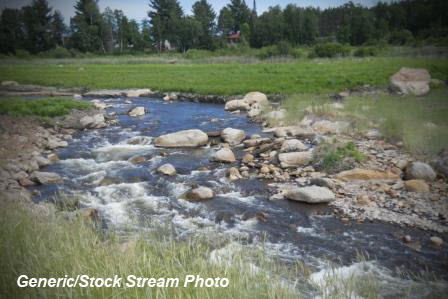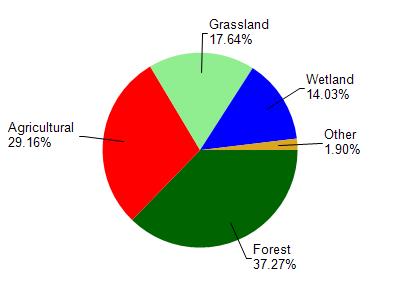
5.90 Miles
27 - 32.90
Macroinvertebrate, Cool-Warm Headwater
2015
Poor
High Phosphorus Levels
Total Phosphorus
Wood
No
No
Yes
Fish and Aquatic Life
Overview
A stream survey conducted by the DNR in 1985 revealed heavy streambank erosion at some locations. Agricultural runoff was also occurring. A barnyard inventory conducted in 1985 identified 17 barnyards with 1,300 head of cattle within 1,000 feet of a major tributary to Hemlock Creek.
The creek also suffers from diurnal shifts in dissolved oxygen concentrations that may be caused by in-stream algal blooms. Both the villages of Arpin and Vesper WWTPs discharge effluents to Hemlock Creek.
Date 2002
Author Aquatic Biologist
Impaired Waters
Hemlock Creek was recently evaluated during the ten-year period of 2009 through 2018 for results that were reported to the USEPA for the 2020 Clean Water Act condition report. The waterbody is considered impaired, or in poor condition for designated uses which include the quality of fish and aquatic life, recreational use, and public health and welfare (fish consumption and related). Pollutants or problems encountered during sampling (impairments) are determined based on water quality standards outlined in Wisconsin 2020 Consolidated Assessment and Listing Methodology (WisCALM). Assessment results show water conditions that are potentially harmful for Aquatic Life use due to values for total phosphorus that fall into the range expected for an aquatic community in poor health, therefore this water is listed as impaired. Hemlock creek is part of the Wisconsin River TMDL that was approved by the USEPA in 2019.
Hemlock Creek (mile 0-27): This segment has been listed since 2012 for total phosphorus and assessments during subsequent listing cycles have confirmed impairment.
Hemlock Creek (mile 27?37.86): Assessment results during the 2020 listing cycle show new impairment by high total phosphorus levels. Based on the most updated information, this segment was proposed for the impaired waters list.
Date 2019
Author Ashley Beranek
Impaired Waters
Hemlock Creek (1366300) was assessed during the 2016 listing cycle; total phosphorus sample data exceed 2016 WisCALM listing criteria for the Fish and Aquatic Life use and biological impairment was observed (i.e. at least one macroinvertebrate or fish Index of Biotic Integrity (IBI) scored in the poor condition category).
Date 2015
Author Aaron Larson
Condition
Wisconsin has over 84,000 miles of streams, 15,000 lakes and milllions of acres of wetlands. Assessing the condition of this vast amount of water is challenging. The state's water monitoring program uses a media-based, cross-program approach to analyze water condition. An updated monitoring strategy (2015-2020) is now available. Compliance with Clean Water Act fishable, swimmable standards are located in the Executive Summary of Water Condition in 2018. See also the 'monitoring and projects' tab.
Reports
Recommendations
Monitor Water Quality or Sediment
2013 TP: "Insuf Data: Prelim Result-Clearly Exceeds". Missing a September sample. Station 10016616. AU 18327. Miles Possible TP listing in 2020. Other AU is already listed for TP.
Management Goals
Wisconsin's Water Quality Standards provide qualitative and quantitative goals for waters that are protective of Fishable, Swimmable conditions [Learn more]. Waters that do not meet water quality standards are considered impaired and restoration actions are planned and carried out until the water is once again fishable and swimmable
Management goals can include creation or implementation of a Total Maximum Daily Load analysis, a Nine Key Element Plan, or other restoration work, education and outreach and more. If specific recommendations exist for this water, they will be displayed below online.
Monitoring
Monitoring the condition of a river, stream, or lake includes gathering physical, chemical, biological, and habitat data. Comprehensive studies often gather all these parameters in great detail, while lighter assessment events will involve sampling physical, chemical and biological data such as macroinvertebrates. Aquatic macroinvertebrates and fish communities integrate watershed or catchment condition, providing great insight into overall ecosystem health. Chemical and habitat parameters tell researchers more about human induced problems including contaminated runoff, point source dischargers, or habitat issues that foster or limit the potential of aquatic communities to thrive in a given area. Wisconsin's Water Monitoring Strategy was recenty updated.
Grants and Management Projects
Monitoring Projects
| WBIC | Official Waterbody Name | Station ID | Station Name | Earliest Fieldwork Date | Latest Fieldwork Date | View Station | View Data |
|---|
| 1366300 | Hemlock Creek | 10011595 | Hemlock Creek - Hemlock Creek Remap 0023 | 10/21/2009 | 1/1/2015 | Map | Data |
| 1366300 | Hemlock Creek | 10016616 | Hemlock Creek - 20 M Downstream Of Cth Hh | 10/18/2001 | 1/1/2015 | Map | Data |
| 5546577 | Unnamed | 10016616 | Hemlock Creek - 20 M Downstream Of Cth Hh | 10/18/2001 | 1/1/2015 | Map | Data |
| 1366300 | Hemlock Creek | 723105 | Hemlock Creek - Sth 186 Vesper | 10/6/1975 | 12/29/1975 | Map | Data |
| 1366300 | Hemlock Creek | 723314 | Hemlock Creek - Hemlock Creek 0023-X | | | Map | Data |
| 1367700 | Unnamed | 723056 | Hemlock Creek at Cth Hh Ab Vesper | 10/6/1975 | 12/29/1975 | Map | Data |
| 1366300 | Hemlock Creek | 723104 | Hemlock Creek - Above Sanna Inc | | | Map | Data |
| 1366300 | Hemlock Creek | 10008330 | Hemlock Creek Sth 186 Site 3 | | | Map | Data |
| 1366300 | Hemlock Creek | 723313 | Hemlock Creek - 0023-B at Hwy 186 | 5/20/1998 | 1/1/2015 | Map | Data |
| 1367700 | Unnamed | 723103 | Hemlock Creek - Beatrice Foods Co Vesper 001 | 10/6/1975 | 12/29/1975 | Map | Data |
| 1366300 | Hemlock Creek | 10033886 | Hemlock Creek at STH 186 | 1/1/2015 | 1/1/2015 | Map | Data |
| 1366300 | Hemlock Creek | 10016594 | Hemlock Creek - 400 Feet Upstream Of Cth Hh | 5/24/1993 | 5/24/1993 | Map | Data |
| 1367700 | Unnamed | 723059 | Hemlock Creek at Dam Bl Vesper | | | Map | Data |
| 1366300 | Hemlock Creek | 10008274 | Hemlock Creek at Cth Hh | | | Map | Data |
|

Watershed Characteristics
Hemlock Creek is located in the Hemlock Creek watershed which is 96.39 mi². Land use in the watershed is primarily forest (37.20%), agricultural (29.10%) and a mix of grassland (17.60%) and other uses (15.90%). This watershed has stream miles, lake acres and 12,264.07 wetland acres.
Nonpoint Source Characteristics
This watershed is ranked High for runoff impacts on streams, Low for runoff impacts on lakes and High for runoff impacts on groundwater and therefore has an overall rank of High. This value can be used in ranking the watershed or individual waterbodies for grant funding under state and county programs.However, all waters are affected by diffuse pollutant sources regardless of initial water quality. Applications for specific runoff projects under state or county grant programs may be pursued. For more information, go to surface water program grants.
Hemlock Creek is considered a Macroinvertebrate, Cool-Warm Headwater under the state's Natural Community Determinations.
Natural communities (stream and lake natural communities) represent model results and DNR staff valiation processes that confirm or update predicted conditions based on flow and temperature modeling from historic and current landscape features and related variables. Predicated flow and temperatures for waters are associated predicated fish assemblages (communities). Biologists evaluate the model results against current survey data to determine if the modeled results are corect and whether biological indicators show water quaity degradation. This analysis is a core component of the state's resource management framework. Wisconsin's Riverine Natural Communities.
Cool (Warm-Transition) Headwaters are small, sometimes intermittent streams with cool to warm summer temperatures. Coldwater fishes are uncommon to absent, transitional fishes are abundant to common, and warm water fishes are common to uncommon. Headwater species are abundant to common, mainstem species are common to absent, and river species are absent.